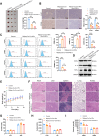Targeted nanoparticle delivery system for tumor-associated macrophage reprogramming to enhance TNBC therapy
- PMID: 40056273
- PMCID: PMC11890257
- DOI: 10.1007/s10565-025-10001-1
Targeted nanoparticle delivery system for tumor-associated macrophage reprogramming to enhance TNBC therapy
Abstract
Triple-negative breast cancer (TNBC) poses as a daunting and intricate manifestation of breast cancer, highlighted by few treatment options and a poor outlook. The crucial element in fostering tumor growth and immune resistance is the polarization of tumor-associated macrophages (TAMs) into the M2 state within the tumor microenvironment (TME). To address this, we developed M2 targeting peptide-chitosan-curcumin nanoparticles (M2pep-Cs-Cur NPs), a targeted delivery system utilizing chitosan (Cs) as a carrier, curcumin (Cur) as a therapeutic agent, and targeting peptides for specificity. These NPs effectively inhibited TNBC cell proliferation (~ 70%) and invasion (~ 70%), while increasing the responsiveness of tumors to anti-PD-L1 treatment (~ 50% survival enhancement) in vitro and in vivo. Bioinformatics analysis suggested that Cur modulates TAM polarization by influencing key genes such as COX-2, offering insights into its underlying mechanisms. This study highlights the potential of M2pep-Cs-Cur NPs to reverse M2 polarization in TAMs, providing a promising targeted therapeutic strategy to overcome immunotherapy resistance and improve TNBC outcomes.
Keywords: COX-2; Curcumin; Immunotherapy resistance; Nanoparticles; Reprogramming; Triple-negative breast cancer; Tumor-associated macrophages.
© 2025. The Author(s).
Conflict of interest statement
Declarations. Ethical statement: All animal experiments were approved by the Animal Ethics Committee of China Medical University (No. CMUKT20240259). Competing interests: The authors declare no competing interests.
Figures









References
-
- Aghbashlo M, Amiri H, Moosavi Basri SM, Rastegari H, Lam SS, Pan J, et al. Tuning chitosan’s chemical structure for enhanced biological functions [Internet]. Trends in Biotechnology. Elsevier BV. 2023; pp 785–97. [cited 2025 Jan 16]. Available from: 10.1016/j.tibtech.2022.11.009. - PubMed
-
- Asadollahi L, Mahoutforoush A, Dorreyatim SS, Soltanfam T, Paiva-Santos AC, Peixoto D, et al. Co-Delivery of erlotinib and resveratrol via nanostructured lipid Carriers: A synergistically promising approach for cell proliferation prevention and ROS-Mediated apoptosis activation [Internet]. International Journal of Pharmaceutics. Elsevier BV. 2022; p 122027 [cited 2025 Jan 16]. Available from: 10.1016/j.ijpharm.2022.122027. - PubMed
-
- Bai X, Oberley‐Deegan RE, Bai A, Ovrutsky AR, Kinney WH, Weaver M, et al. Curcumin enhances human macrophage control of Mycobacterium tuberculosis infection [Internet]. Respirology. Wiley. 2016, pp 951–7 [cited 2025 Jan 16]. Available from: 10.1111/resp.12762. - PubMed
-
- Barkal AA, Brewer RE, Markovic M, Kowarsky M, Barkal SA, Zaro BW, et al. CD24 signalling through macrophage Siglec-10 is a target for cancer immunotherapy [Internet]. Nature. Springer Science and Business Media LLC. 2019; pp 392–6 [cited 2025 Jan 16]. Available from: 10.1038/s41586-019-1456-0. - PMC - PubMed
MeSH terms
Substances
Grants and funding
LinkOut - more resources
Full Text Sources
Research Materials

